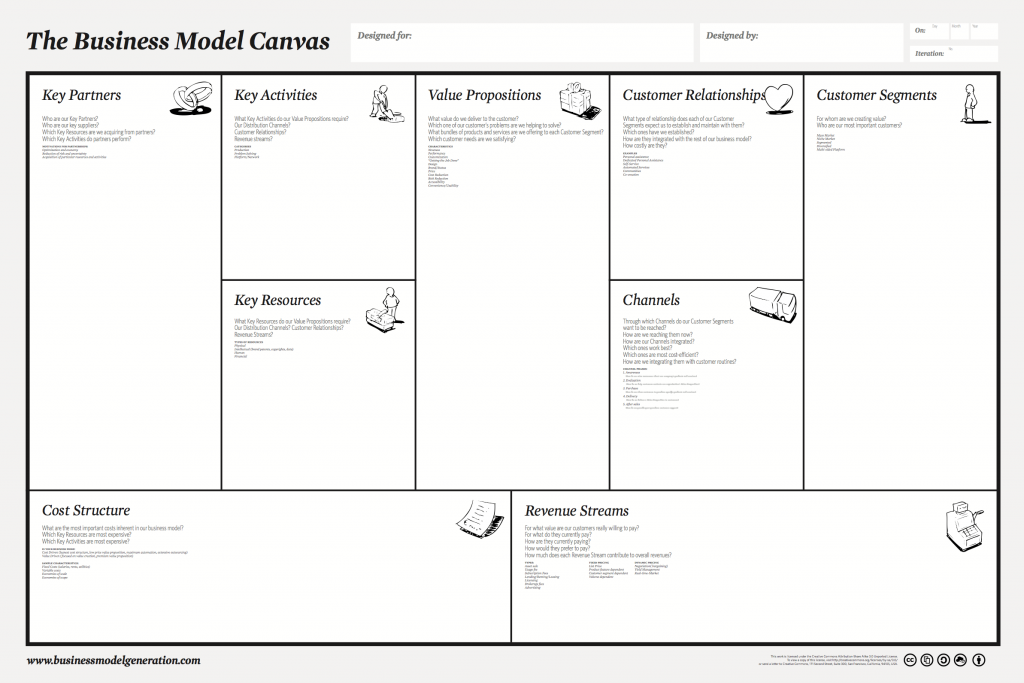Business Model Canvas
Why Business Model Canvas?
Every idea needs a functioning business model, if it is to hold up in the long run and reach as many people as possible. It is easier to actualise a bad idea with a good business model than the best idea without. Business Model Canvas helps to combine all the essential elements of a successful business model in a scalable system. As a Startup, in which the business model is usually not perfectly clear, you can quickly compare different versions. Even existing business models in innovative companies can rapidly develop further with BMC to get ideas about how the company could operate in 2, 5 or 10 years. The following 2-minute video explains how the Business Model Canvas works.
Business Model Canvas instead of Business Plan
Business Model Canvas has become an important element of the Lean Startup philosophy. Alexander Osterwalder shows in the following presentation how the Business Model Canvas is used in the context of Lean Startup and Customer Development.
Would you like to know more?
Subscribe to our newsletter and get your free „Business Model Canvas“ White Paper now!
The 9 Elements of Business Model Canvas
Simply download the Business Model Canvas PDF, print it out and begin to visualize your first business models with post-its. Many thanks to Alexander Osterwalder, who has released the PDF at BusinessModelGeneration.com under Creative Commons.
Customer Segments
Every startup has a specific audience in mind, or is at least looking for market segments that benefit from the added value of its products. This could include anything from a small niche to the mass market. Perhaps it’s a „multi-sided market“, in which the user is not always the customer, such as in the case of Google search (user: searcher / customer: advertiser). Through validated learning the profile of the customer segment should become increasingly clearer and fit optimally to the Value Proposition. Who are your target audiences?
Value Propositions
Businesses, regardless of size, basically have one central task. They solve certain problems or needs their customer might have. This is known in Business Model Canvas as „value proposition“. The product offered by your Startup can newer, better, more appropriate, more stylish, more affordable, or simply more user-friendly than those given, in order to solve the problems of the customer segment. What benefits do your customers have when they work with you?
Channels
This is how you interact with your customers … starting with attracting attention for the product, through distribution channels and delivery to after-sales service. How do your customers come to know about your offer and how do they get it?
Customer Relationships
Customers expect, depending on the offer, a certain kind of service and treatment. Many tech startups offer Software as a Service (SaaS) in the B2C market, where the interaction is almost fully-automated. Another startup might offer customisable services which make direct human interaction necessary. How you design the customer relationship is an important part of the business model and should be clearly defined. How do you to get, keep, and upgrade your customers?
Revenue Streams
There are often several ways to earn money from the same value proposition. The Business Model Canvas can be used especially in this area to try out different options and identify new business models. One-off payments bring money in quickly, whereas subscribers promise continuous cash flow over time. Perhaps elements of the value proposition to offer can be licensed or rented out. After these more strategic considerations it is time to ask questions about the pricing model. Where does the money come from in this business model?
Key Resources
As a startup, one is often even moreso reliant upon certain resources in order to bring a value proposition to market, because the infrastructure is still in its infancy. What physical, human and financial resources are indispensable?
Key Activities
In order to actualise the value proposition, certain central activities are required. The development of an app, new solutions for clients or networks should be included in this section of the Business Model Canvas. What are the key activities to keep this business model going?
Key Partnerships
Depending on the business model, it is advisable as a startup to enter into a strategic partnership with non-competitors, suppliers or service providers in order to reduce risk or to ensure scalability. Who are your most important partners?
Cost Structure
Costs arise in areas of implementation, especially for Key Activites, Resources and Partnerships. With this in mind, the most important cost items should be detected quickly. What are your most important expenses, without which the business model would not run?
| Datum | Veranstaltung |
|---|
Recommended Reading: Alexander Osterwalder’s „Business Model Generation“
Alexander Osterwalder, born in 1974, is himself an Entrepreneur and a highly-regarded business model innovator. His Startup „Business Model Foundry“ has set itself the task of developing new tools for innovators and startups. As author and speaker, he’s traveled the world and has reached over 5,000,000 people with his Business Model Canvas We heartily recommend his book Business Model Generation: A Handbook for Visionaries, Game Changers, and Challengers and website businessmodelgeneration.com.





